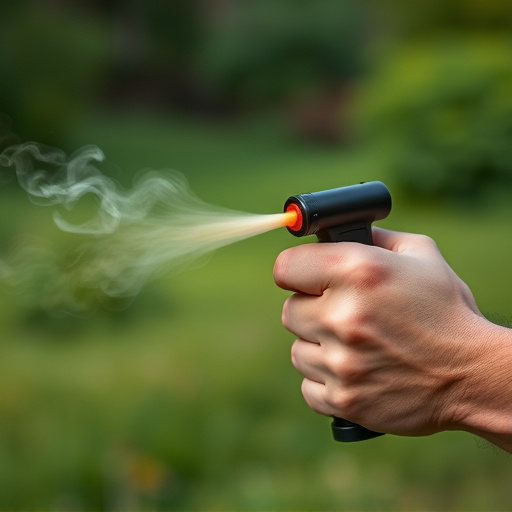TL;DR:
Pepper spray exposure treatment involves immediate safety measures, eye flushing with water, and monitoring symptoms that typically last 20-60 minutes. Effectiveness varies based on exposure time (2-5 seconds to 4 hours) and individual sensitivity. Mild cases resolve in 15-30 minutes, while severe cases may require medical intervention up to several days. Training in correct deployment techniques, timing, and treatment times is crucial for maximizing its impact as a non-lethal deterrent, enhancing personal security.
“Discover the power of non-lethal deterrents with a focus on pepper spray—a personal security device saving lives and mitigating risks. This article unravels the dynamics of pepper spray, including its effectiveness, exposure time, and treatment protocols. Learn about the strategic use of such devices in self-defense scenarios, where training and the right equipment can make all the difference. Explore the critical aspects of understanding and managing pepper spray exposure, including recovery timelines, to empower individuals with essential knowledge for personal safety.”
- Understanding Pepper Spray: A Non-Lethal Deterrent
- Exposure Time: How Long Does it Take for Pepper Spray to Work?
- Treatment and Recovery: What to Expect After Pepper Spray Exposure
- The Role of Training and Personal Security Devices in Self-Defense
Understanding Pepper Spray: A Non-Lethal Deterrent
Pepper spray is a popular and effective non-lethal deterrent used for personal security. When deployed, it creates an immediate challenge for potential assailants by causing temporary blindness, coughing, and difficulty breathing. The active ingredient in pepper spray, capsaicin, irritates the eyes, nose, and respiratory system, neutralizing the threat without causing permanent harm. Understanding the exposure time and treatment required is crucial to ensuring its effectiveness.
The treatment time for pepper spray exposure varies based on factors such as the amount sprayed, wind direction, and clothing worn. Typically, symptoms can last between 20 minutes to an hour. During this period, it’s essential to move to a safe location, remove contaminated clothing, and flush eyes with water. Immediate action increases the likelihood of minimizing discomfort and prevents further complications. Proper training in pepper spray handling and awareness of exposure signs can significantly enhance personal security.
Exposure Time: How Long Does it Take for Pepper Spray to Work?
The effectiveness of pepper spray as a non-lethal deterrent depends, in part, on the exposure time—how long the target is affected by its irritant properties. Unlike some fictional depictions, pepper spray doesn’t instantly paralyze or knock an attacker out; instead, it causes a temporary but intense irritation of the eyes, nose, and throat, leading to coughing, tears, and difficulty breathing. This disruption can create enough distance for a victim to escape or gather help.
The exposure time varies based on several factors including the amount of spray used, the proximity of the attacker, and individual sensitivity. Typically, pepper spray takes effect within 2-5 seconds after inhalation or contact with the eyes and skin. The effects usually last between 20 to 60 minutes, though some varieties can provide protection for up to 4 hours. Proper use, including aiming for the face and breathing deeply upon application, can ensure the maximum impact and exposure time, thereby enhancing personal security.
Treatment and Recovery: What to Expect After Pepper Spray Exposure
After exposure to pepper spray, it’s crucial to understand that treatment and recovery time can vary significantly from person to person. The severity of symptoms depends on factors like the amount of spray inhaled, duration of contact, and individual sensitivity. In most cases, mild symptoms like watery eyes, coughing, and difficulty breathing subside within 15 to 30 minutes without lasting effects. However, more severe reactions may require medical attention.
For individuals experiencing intense pepper spray exposure, treatment might involve oxygen therapy, eye flushing, and antihistamines to alleviate irritation and inflammation. Recovery time for these cases could extend from several hours to even a couple of days. It’s essential to stay hydrated, avoid strenuous activities, and monitor symptoms closely during the recovery period. Seeking medical advice is recommended if symptoms persist or worsen beyond 24 hours.
The Role of Training and Personal Security Devices in Self-Defense
Training and education play a pivotal role in enhancing personal security, especially when paired with the right self-defense tools. In today’s world, individuals seeking to protect themselves often turn to non-lethal deterrents like pepper spray as a first line of defense. Effective training ensures that users understand not just how to deploy these devices, but also the strategic timing and exposure treatment time required for maximum impact.
Knowledgeable individuals can learn to administer the correct amount of pepper spray, ensuring it disrupts an assailant’s vision and breathing without causing long-term harm. This preparation, combined with regular practice, enables people to respond calmly in potentially dangerous situations, making personal security devices more effective and empowering individuals to take control of their safety.
In conclusion, pepper spray serves as a valuable non-lethal deterrent for personal security, with an exposure time that can incapacitate an attacker briefly. However, understanding the treatment and recovery process after pepper spray exposure is crucial. Effective self-defense involves not only proper usage but also adequate training and the adoption of personal security devices. By equipping ourselves with knowledge and tools like these, we can enhance our safety and peace of mind in various situations.
